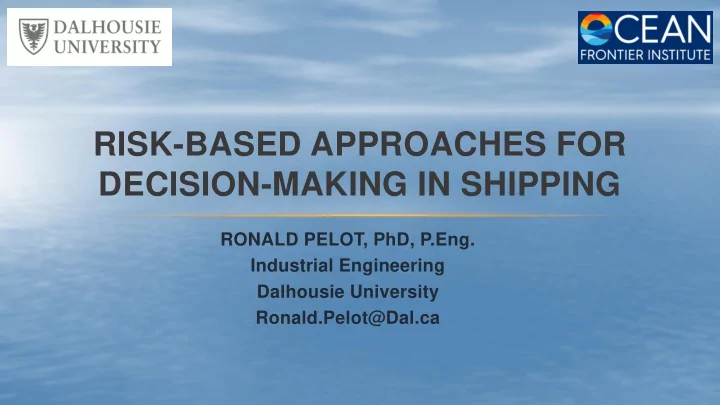

RISK-BASED APPROACHES FOR DECISION-MAKING IN SHIPPING RONALD PELOT, PhD, P.Eng. Industrial Engineering Dalhousie University Ronald.Pelot@Dal.ca
OVERVIEW • What is risk analysis in shipping? • What is the scope of shipping risks in this Module? • What role does risk analysis play in decision-making? • Need for ongoing research
WHAT IS RISK ? • Risk is the possibility of an event occurring that will have an impact on the achievement of objectives. • Risk is measured in terms of impact and likelihood: • Risk = probability * consequences
WHAT ARE THE OBJECTIVES? (wrt managing the shipping risks) • Whose objectives? • Government/country • Shipping industry • Other industry • Northern communities • Types of objectives • Minimize environmental impact • Maximize safety in shipping • Maximize efficient movement of goods • Contribute to Sustainable Development of the North
IMPACT TYPES AND SOURCES OF UNCERTAINTY • Risks to ships? • Risks from ships? • Delays • Noise • Accidents • Discharges (incl. oil) • Damage to ships • Invasive species (ballast) • SAR response • Air emissions • Spills • Mammal strikes • Spill response • Light disturbance • To crew/passengers • Interference with other activities • etc. • etc.
CUMULATIVE EFFECTS → chain of probabilities Priscilla Schmitz, Dalhousie 1 P(ship be at 5 location [x,y]) P(receptor be affected) 2 P(stressor happens at location [x,y]) 4 3 P(receptor be P(spread of stress inside the affected from source[x,y]) area)
EVENT Ensuing Delivery Immediate Ultimate Consequences Hazards Mechanism Consequences State RISK AND DECISION Recovery Prevention Detection Response MAKING – Vulnerability Resilience PHASES AND TRADEOFFS Strategies Pelot, 2008
RISK GOVERNANCE ̶ DRIVERS & DEVELOPMENTS (RENN, 2007) • Governance refers to the actions, processes, laws, traditions and institutions by which authority is exercised and decisions are taken and implemented. • Risk is an uncertain (positive or negative) consequence of an event or an activity with respect to something that humans value • Risk governance refers to the actions, processes, laws, traditions and institutions by which decisions about risk handling are prepared, taken and implemented • Best practice in risk governance integrates the principles of good governance within the processes of risk identification, assessment, management and communication and includes criteria such as effectiveness, accountability, efficiency, fairness and social and ethical acceptability INTRODUCING THE IRGC’S RISK GOVERNANCE FRAMEWORK
COMMON DEFICITS IN RISK GOVERNANCE (RENN, 2007) • Framing – different stakeholders have conflicting views of the issue • Scope – a risk perceived as only local may have global consequences (and vice versa) • There is a scarcity of data about the risk or people’s perceptions of it or, if data does exist, there is a failure to accept it • Transparency – trade-offs are not made explicit and hidden agendas seem to determine the outcome • Inequity – decisions allot the risk and benefits unfairly • Accountability – decision makers are isolated from the impact of their decision • Alienation – people or organisations are ignored (can lead to social mobilisation) (also “Authority knows best”) • Lack of trust in the process or the communication channel • “Paralysis by analysis” – overly inclusive process leads to inertia INTRODUCING THE IRGC’S RISK GOVERNANCE FRAMEWORK
HOW CATEGORISING THE KNOWLEDGE CAN HELP (RENN, 2007) • Simple risk problems • Cause/effect understood; management options relatively straightforward • can be managed using a ‘ routine- based’ strategy , such as introducing a law or regulation • Complex risk problems • difficulties in identifying and quantifying causal links between a multitude of potential causal agents and specific observed effects. • may be best addressed by accessing and acting on the best available scientific expertise, aiming for a ‘ risk-informed ’ and ‘robustness - focussed’ strategy • Uncertain risk problems • lack of clarity or quality of the scientific or technical data (ex. some rare/extreme events) • are better managed using ‘ precaution-based ’ and ‘resilience - focussed’ strategies , to ensure the reversibility of critical decisions and to increase a system’s capacity to cope with surprises • Ambiguous risk problems • results from divergent or contested perspectives on the justification, severity or wider meanings associated with a given threat (ex. Shipment of hormone treatment of cattle) • require a ‘dialogue - based’ strategy aiming to create tolerance and mutual understanding of conflicting views and values with a view to eventually reconciling them INTRODUCING THE IRGC’S RISK GOVERNANCE FRAMEWORK
RISK TYPES AND MANAGEMENT IMPLICATIONS (RENN, 2007)
SUMMARY • The uncertainties in arctic shipping are large • The potential consequences are large ( + and - ) • Research can help reduce the uncertainty • Effective use of the research can help formulate effective, equitable, evidence-based management strategies Thanks! Ronald.Pelot@Dal.ca
Recommend
More recommend